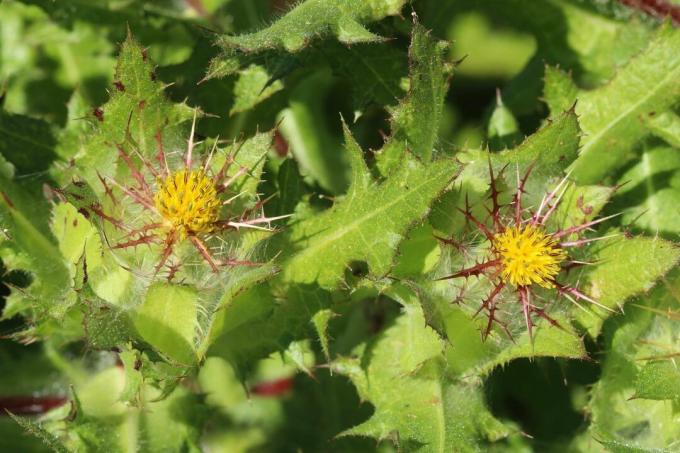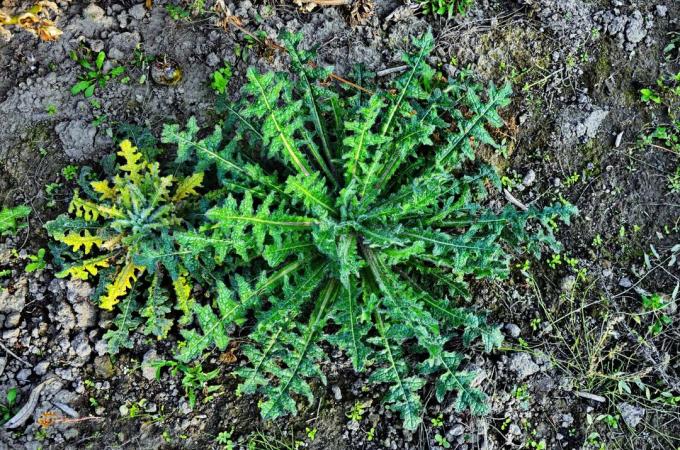The St. Benedict herb can be used as an effective medicinal plant for digestive problems. With us you will learn everything about the planting, harvesting and healing effects of Benedict herb.

Benediktenkraut (Centaurea benedicta) is a largely forgotten and unknown medicinal plant. We present the thistle-like plant in the profile and give tips on growing Benediktenkraut.
contents
- Benedict herb: origin and properties
- Grow Benedict Herb
- The right care
- Harvest, use and effect of Benediktenkraut
Benedict herb: origin and properties
Benedict herb belongs to the daisy family (Asteraceae) and is also known as Cardo Benedict herb, thistle herb, heather thistle or bitter thistle. According to recent findings, the species is one of the most diverse knapweed (Centaurea), the older botanical names Cnicus benedictus and Carduus benedictus however, are still in circulation. Benedict herb originally comes from the Mediterranean and the Caucasus. It is mainly cultivated in Spain and Italy as a medicinal plant.

The annual Benediktenkraut reaches a growth height of 10 - 50 cm and looks very similar to a thistle. The shaggy hairy medicinal plant grows upright to prostrate and branches out. Their large, alternate leaves are serrated and prickly at the leaf edge. Benedict's herb forms a basal leaf rosette with stalked leaves, while the upper leaves of the flower stalks are tight fitting and embrace the stalk. Between June and August, if sown in autumn from May, the tube-like, yellow flowers of the Benediktenkrauts, which are on a wreath of pointed, pinnate, creamy white to burgundy bracts sit. The pollen-rich flowers are popular with bees and other pollinators. After pollination, oblong, lightly grooved, dark brown seeds with a bristly appendage form. The bitter taste of the leaves is typical of the Cardo Benedictine herb.
Is Benedictine a weed? The Benedict thistle is not considered a significant weed in our latitudes. In the Mediterranean area, it is increasingly found on field edges, but is only very occasionally found in the wild in this country.

Grow Benedict Herb
Benedictine prefers a location in full sun on well-drained, moderately nutrient-rich, moderately dry to moderately moist soil. Rock gardens and steppe beds are ideal for planting with Benedict herb. The medicinal plant can be cultivated in beds as well as in pots and planters. The planter should have a volume of at least five liters to ensure a good water supply. The annual medicinal plant is cultivated by sowing seeds between April and May or for overwintering culture from the end of September directly outdoors. As a leaf rosette, the Benediktenkraut is extremely hardy, but as soon as the first flowers form, the plant becomes much more sensitive to cold. The seeds of Benediktenkraut are only covered to 0.5 - 1 cm with substrate. Germination takes a few weeks but can be accelerated by soaking the seeds in warm water for 24 hours. Pre-cultivation indoors from March is also possible. A nutrient-poor substrate such as our peat-free one is suitable for this Plantura Organic Herb & Seed Soil. It ensures good aeration of the roots and reduces the risk of waterlogging and root rot.
From mid-May, the early young plants can be planted out in nutrient-rich substrate or normal garden soil. The distance between individual plants should be 20-30 cm. Prepare the soil before planting, remove unwanted weeds and loosen the substrate. For the cultivation of Benediktenkraut in the pot, a 5 - 10 cm high drainage layer made of gravel, sand or expanded clay should be filled in at the bottom of the pot under the layer of soil in order to avoid waterlogging. The young plants are then planted with a hand shovel. In directly sown rows, plants that have germinated too close together should be separated at a distance of 20 - 30 cm. After planting, it is watered extensively.
The right care
Benediktenkraut requires little care. In the young plant stage, it is worth removing the weeds regularly between the rows and the individual plants. This also makes harvesting easier later, since no unwanted or even poisonous plants have to be sorted out after the cut. Irrigation is only necessary in very dry and hot summers. The only relevant disease in unfavorable summers is powdery mildew (Erysiphe cichoracearum), which can occur before harvest.

Harvest, use and effect of Benediktenkraut
The Benedict herb is harvested shortly before or during flowering, as it contains the highest levels of active substances at this stage. The whole plant is used with the exception of the root. The weed can be removed quickly and easily with garden shears. Tinctures or herbal liqueurs can be prepared directly with fresh leaves. To use for teas, the plants should be spread out and left to dry in a warm, airy place for a few weeks. The dry herb can be chopped up and stored in an airtight container.
St. Benedict contains essential oils and bitter substances such as cnicin and artemisiifoline, which have a positive effect on gastric juice, gallbladder and liver. Benedictine tea is usually used for diarrhea, nausea, loss of appetite and general digestive problems made from the dried medicinal plant, with the daily dose being four to six grams of the dried herb lies.

A proven combination for stone problems and heartburn is the Kardobenedikten wine, which in addition to Benediktenkraut also vermouth (Artemisia absinthium), Centaury (centaurion) and white horehound (Marrubium vulgare) are included in equal parts.
In pregnancy and breastfeeding, but also with a known allergy to daisy family, such as arnica (Arnica montana), yarrow (Achillea) or chamomile (Matricaria recutita), but the use of Benedictine herb should be avoided in order to avoid allergic reactions.
Another relatively unknown medicinal plant that grows wild in many places is the mullein (verbascum). With us you will learn everything about the different types, the cultivation and use of the mullein.
